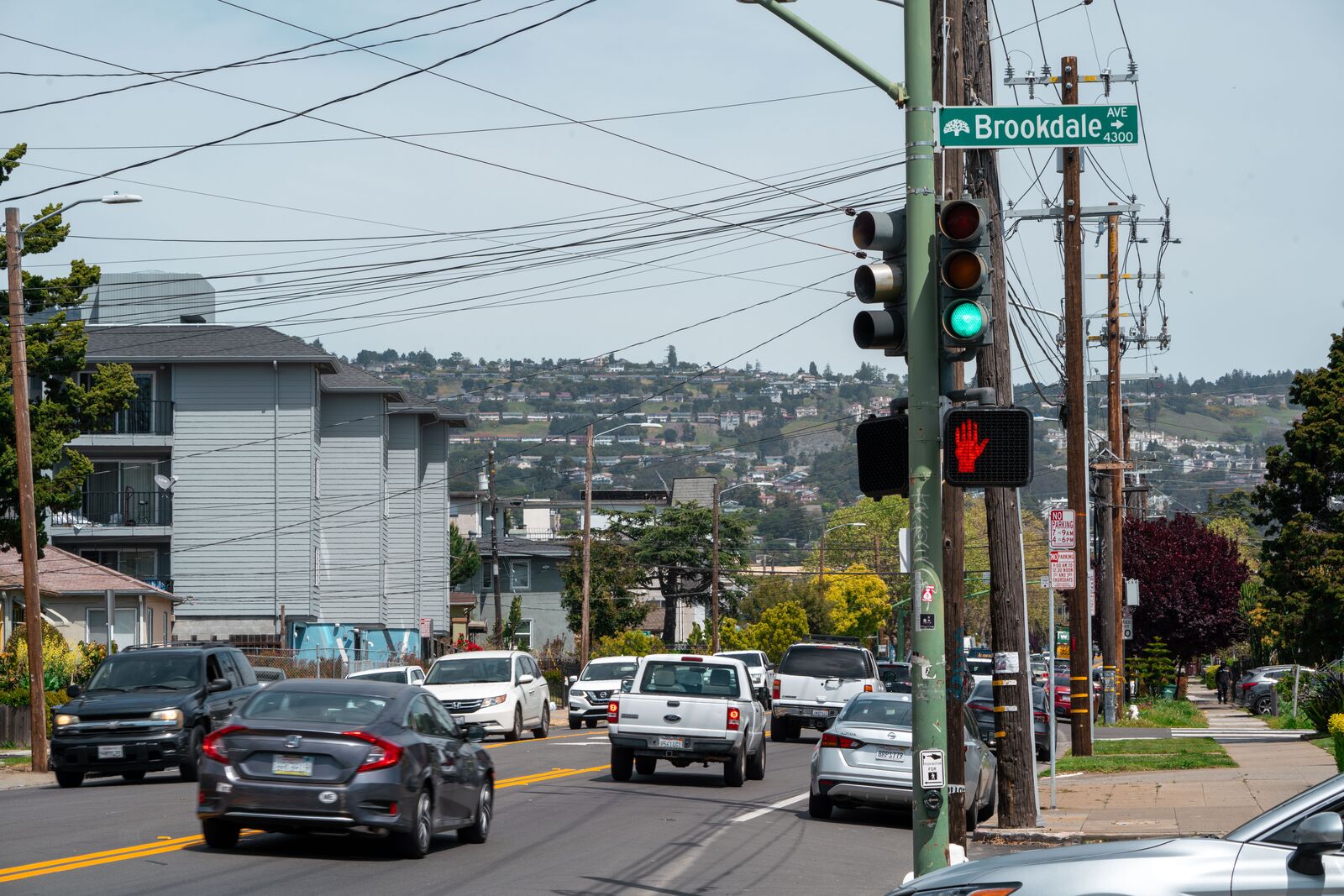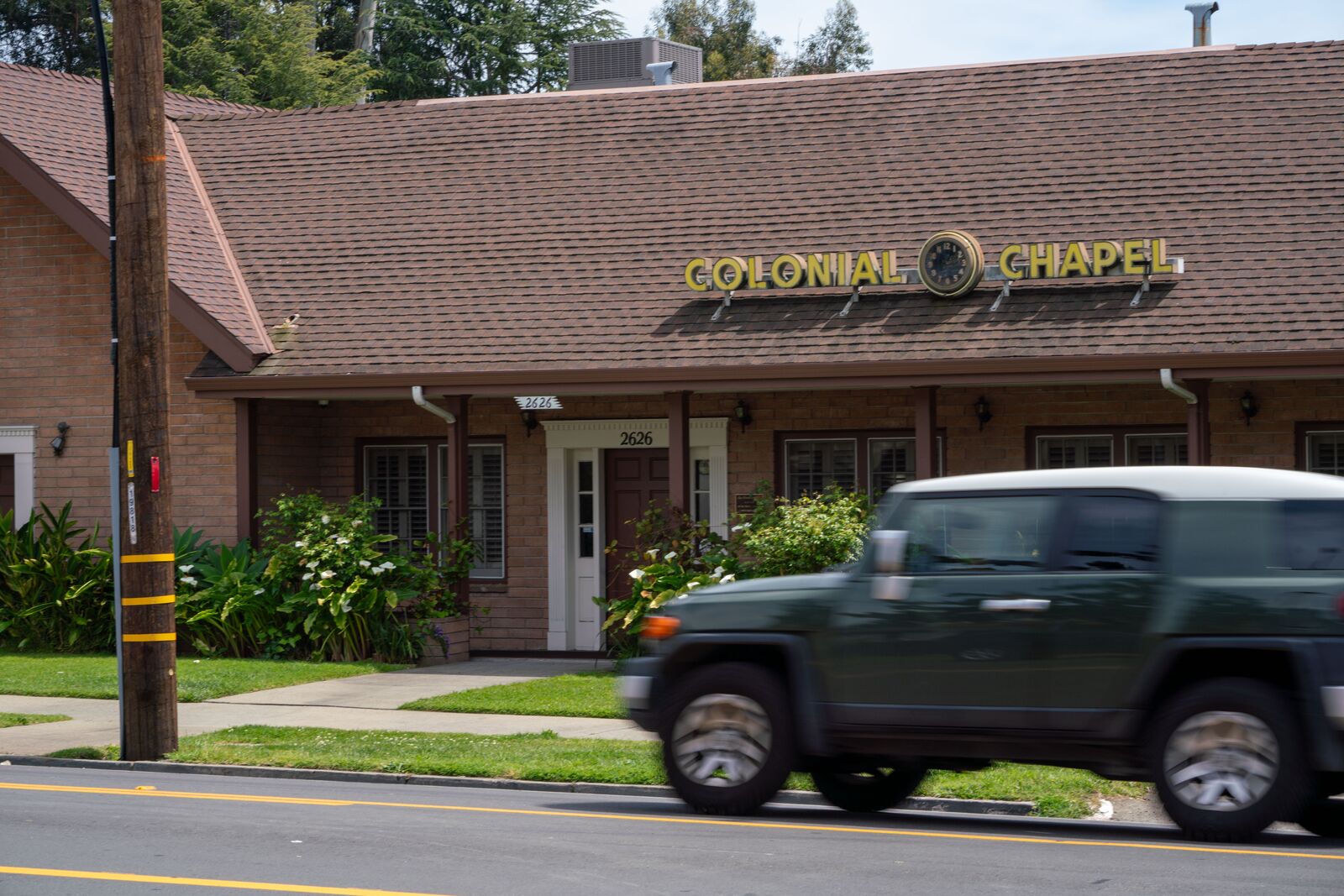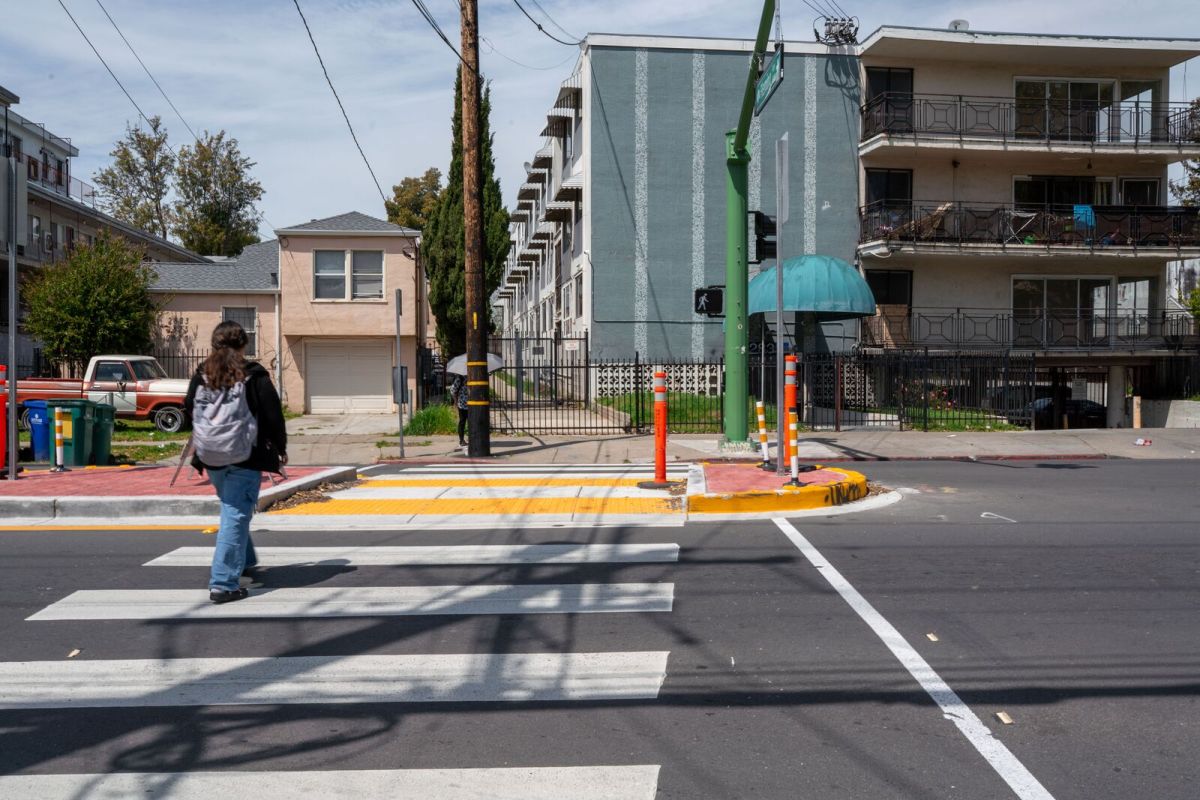One of Oakland’s biggest paving projects in recent years is nearly complete: the 21-block resurfacing of High Street. The city’s transportation department took advantage of the repaving to add numerous other traffic safety infrastructure improvements to the road, including concrete medians at intersections, new curb ramps for sidewalks, and pedestrian crossing beacons to encourage drivers to slow down.
The Oaklandside visited High Street several times over the past couple of weeks to talk with more than a dozen locals, many of them long-time residents, asking them how they feel about the changes. Most said the road work has improved things, but they still don’t feel safe. They still see people speeding daily, leading to injury crashes, close calls, and frayed nerves.
High Street is one of the most important arterial roads in East Oakland because it connects the Laurel, Maxwell Park, Fruitvale, Allendale, and Fairfax neighborhoods to the 580 freeway and other major roads, including Foothill, International and MacArthur boulevards. It’s one of the city’s most dangerous roads, with several fatalities and over 200 collisions between Foothill and Tompkins Avenue in the last 10 years, according to city records. A quarter of all collisions on the High Street were caused by speeding simultaneously.
Residents say excessive speeding is still the number one problem

Most High Street residents we spoke with praised the road’s improvements, but several said that speeding, the most dangerous behavior before the paving project, is still a big problem.
Some said they still do not want to walk on the sidewalk for fear of an out-of-control car. Bicyclists said they still use parallel streets to travel along the corridor rather than risking the busy main road. One resident we met even texted us the day after our interview with them, sending photos from a severe collision on High Street that ended with a destroyed car that jumped the sidewalk and rammed a utility pole. Luckily, no one was seriously hurt.
Norman Lemon, a longtime High Street resident, told us he thinks the smoother pavement is actually causing more speeding because it now resembles a race track and drivers’ tires can better grip the road. Five minutes after we spoke to Lemon near the corner of Brookdale Avenue, a young man in a Tesla Model Y rapidly accelerated his car up High at least 20 mph above the speed limit.
Juan Ramirez, a young Latino immigrant living in an apartment complex near the Boys & Girls Club, told us he appreciates no longer having to worry about potholes. But the crosswalk on Culver Street, which was repainted with thick white strips and brand new yellow ramp pads at the sidewalk, is still dangerous. The absence of pedestrian lights and a concrete island where people crossing the street could have some safety if cars don’t stop is now noticeable compared to other intersections that got these improvements.
“People just don’t stop when a person is walking on the crosswalk. And with people crossing to the corner store constantly, it’s scary,” he said in Spanish.

Colonial Chapel owner Paul Scudder’s office has a big window onto High Street, so he sees people’s driving behavior. “Nothing’s changed, they all are driving insanely still,” Scudder said.
The morning we spoke to Scudder, he said his car was nearly pushed onto the median while driving to work by a speeding driver going around other cars.
“They’re still going a hundred miles an hour up here. The guys on motorcycles popping wheelies all day, too. The guy that [almost hit me] two hours ago was using the turning lane with a car and cut me off, I slammed my brakes on, and I had to turn the car quickly to avoid him, almost crashing like a maniac,” Scudder said.
With families attending the funeral home every week during challenging times in their lives, Scudder said he has to advise his customers to be careful on their way in and out of the parking lot. Two weeks ago, a man driving a stolen car collided with the power pole outside the funeral home and all his other signs on the lawn, causing Colonial to lose power for two days. When workers came to fix the utility pole they were then robbed at gunpoint.
Jessyca John, an executive assistant at a health insurance company, dislikes driving on High Street because it feels unsafe and too busy. The nearly 20-year resident of the area said the middle turn lane is the problem.
“I think Oakland has a bigger problem with our roads kind of being like the wild, wild West. I’ll be honest. Stop signs are suggestions,” John said about some people’s tendency to blow through intersections without obeying the signs.
Speed cushions added to the road have helped “slightly” slow cars, John said. But the benefit is marginal: “You can ride right over those things at 35 miles an hour,” she said. “It doesn’t slow people down as much as I think they intended it to.”
John said she knows Oakland’s back roads well and can mostly avoid main roads like High Street. But she does have to use High Street to pick up her daughter from school.
“I ran on High during the pandemic when nobody was on the road,” said John. “And then people started getting back on it and I saw car collisions and just didn’t feel safe. Me and my daughter have bikes and we drive them to Emeryville’s bike path or down to Alameda Beach. I will even ride on the sidewalk if I have to when I know you’re not supposed to, ’cause I feel like if I ride in the street, I’m putting my life in danger.”
Are the changes big enough to make High Street safer?

The neighborhoods around the part of High Street that were just repaved are some of the city’s densest population centers, with an average of 15,464 people per square mile, nearly twice the citywide average of 7,878. Most people who live here drive to and from work, making major roads like High Street extremely busy throughout the day.
Locals blamed the road’s design for its dangers. With two driving lanes and a poorly painted and underused center turn lane, many drivers bypass traffic recklessly by speeding in the center lane. This made using the turn lane a dangerous proposition, as speeding drivers could crash head-on into someone else trying to turn left.
Old and broken infrastructure was also at fault—few street lights worked well and there was no pedestrian infrastructure like crossing beacons. Combined with deep potholes, cracks, and an absence of consistent traffic enforcement, many felt the street’s condition encouraged lawlessness.
The repaving project hasn’t addressed these issues along parts of High Street. Most of the center turn lane design has been left in place, still allowing space for illegal speeding. However, at some intersections, the city has added concrete center islands. Sidewalks around intersections have also gotten yellow curb ramps to accommodate more people, including those who use wheelchairs. The new center islands make it easier for drivers to turn left onto local streets.
Rapid-flashing beacons were placed at Carrington Street and Penniman Avenue intersections, while a pedestrian hybrid beacon was added to Fleming Avenue. Previously, this intersection had no lights to alert drivers to yield for pedestrians, which may have led to one person getting hit and dying in the 2010s.
In an update of the design last year, the Oakland Department of Transportation said in planning documents that they chose not to add protected bike lanes on the road after feedback from residents. City planners asked residents in an online survey three years ago about adding bike lanes and more than 700 people answered. Many said they didn’t want bike lanes because it would require removing up to half of the nearly 300 parking spaces between Foothill Boulevard and I-580. Planners were also worried that driving behavior was too chaotic to add a bike lane there.
“Steep grades, lack of space for physical protection of a bike lane, and speeding drivers were the primary factors in not moving forward with the Bike Plan recommendations for this segment of High Street,” the city said in its update last year.
The other significant new addition to High Street is speed cushions, mostly located near the concrete pedestrian islands. The cushions have cut-out spaces for buses but are supposed to slow down most other drivers.
The city told The Oaklandside it will collect data and analyze speeding on the street to determine if the speed cushions have a positive effect. This study will be published later this year.
‘It’s slowed people down’

Jason Owen lives in Maxwell Park on Fleming Avenue and works for Nextdoor, so he’s on top of what people say in his neighborhood. He said a few people are upset traffic appears to have increased after the completion of the paving project, probably because cars are slowing down. To Owen, this means the changes are making things safer.
Before the paving added speed cushions and center islands at Fleming Avenue, he felt unsafe making a left turn from High Street.
“I always felt very uncomfortable sitting in that median lane because of the number of times that I’d seen cars flying at 40, 50, 60 miles an hour,” Owen said.
Owen is part of the High Street Coalition, which cleans up trash and walks the street. He feels safer during the six hours a month that he spends doing that activity with other community members. Walking and cleaning up the street has made him notice that the speed cushions, while helpful to slow down regular drivers, are also not being maintained properly, with trash gathering around and in between, even during street clean-up day.
“One of my big concerns now is that over time, eventually, all of this debris that’s building up in the fronts and the backs of the cushions is just going to eventually turn into weeds growing on them and affecting their [stability],” Owen said. Maybe Public Works staff are skipping them because they don’t know how to clean them.”
Seeing how successful the speed cushions have been, Owen wishes they were more up and down High Street. Like Scudder, the funeral home director, Owen has observed that people still speed illegally in the center lane at the Brookdale Intersection where there are no cushions. He said businesses on that block have boarded-up windows from previous car collisions.
Jess Tatiana Cornejo Flores, a software engineer and Maxwell Park resident, told us she is “really happy with the changes.” Even though new paving or median islands were not implemented into High Street’s busiest main retail area, where the Mexican grocery store Cardenas is located, she feels there’s less speeding.
“I feel safer as a driver on that road, and I think that anywhere that has bus stops is a good candidate for these changes to ensure pedestrians can cross safely,” Cornejo Flores said.
Shwemoor Moore, an Allendale resident, said on Nextdoor that he’s noticed the street is “much safer with slower and safer traffic for the neighborhood and pedestrians.” Moore said High Street used to feel like a “getaway highway for criminals between 880 and 580.”
Saleh bin Ahmed, the owner of Shawarma Time dining at the corner of High Street and Virginia Avenue, told us the repaving project has been good.
“I saw that construction, and yes, it’s slowed down people,” he said.
State Farm Insurance broker Kristen Law told us that she thinks speeding on High Street has slowed down a bit but not between MacArthur and Tompkins Avenue in Laurel.
Teresa Chin has lived off High Street for 11 years. A few years ago, she and her young daughter were hit by a driver who ran the red light while she was making a left turn in her car onto a side street. The islands have made turning safer but the street needs additional infrastructure, she said, including green-arrow-protected turns. “Those concrete medians have made a big difference because turning lanes at those locations used just to be a free-for-all all, people driving and speeding around people who had places to go. But there’s still huge chunks of the street that don’t have that.“
Chin sees the changes as the beginning of an improved neighborhood with potential.
“There are great businesses here. The neighborhood has a lot of people who probably wanna walk, and it has great parks around. You want to be able to get to dance [classes] and stop and get a sandwich at Communite Table and at the donut shop. Who doesn’t want that?” she said.

Merissa Lyons, who runs the Cocobreeze Caribbean restaurant and bakery with her mom, said they’re excited to see improvements. They chose not to put up a parklet on the street even after the city made doing so easier a few years ago because they’d seen so many collisions and knew it would be unsafe for customers to sit in the street.
“Many adolescents and elderly people in the neighborhood walk around these stores. People come from outside the neighborhood to visit Cocobreeze, and we want them to be safe,” Lyons said. “We even walk our Doordashers who pick up food to their cars to make sure that they can safely take the food.”
Lyons said they still worry about customers post-paving, primarily when people use the turning lane to bypass cars. But she thinks the new additions are good because they’re offering a positive alternative in a place where there was none before. Plus, with other, wealthier communities adding road protections and using them to attract customers with a feeling of safety, it’s important places in East Oakland get this kind of attention from planners also.
“We need safe spaces and events to do things here. Otherwise, people will always have to leave and go somewhere else to experience life, and we don’t want that. We want people to be able to enjoy themselves in their backyards,” Lyons said.

